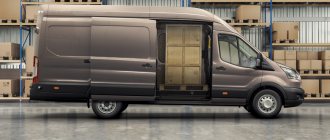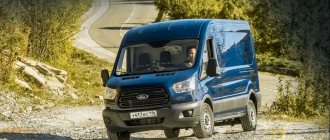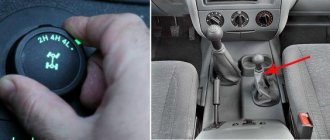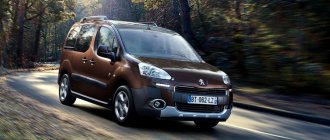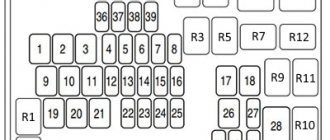Without exaggeration, the Ford Transit light-duty van can be called the most famous vehicle in the commercial segment. Official statistics say that over more than 50 years of production, over 7 million cars have been produced and sold. The company managed to establish production of Ford Transit in Turkey, Belgium, China, and Russia. The main feature of this machine is the ability to mount any superstructure on the chassis that can satisfy the needs of a wide range of consumers.
The popularity of the van is due not only to the variety of modifications, but also to the technological excellence of the vehicle. In terms of equipment, the Ford Transit is practically in no way inferior to any modern passenger car. Today, the eighth generation of models with diesel and gasoline engines under the hood is being produced. Due to its lightness, reliability and excellent handling, the minibus has become widespread on domestic roads. Therefore, it is important to know what the Ford Transit fuel consumption is per 100 km.
front or rear wheel drive (Ford Transit) – Fixed assets
I. Nikitina
Buyers of Ford one-ton trucks are faced with a difficult choice, as these vehicles are available in front- and rear-wheel drive versions. The German magazine Lastauto&Omnibus decided to find out the strengths and weaknesses of both versions.
There is a fierce competition in this class of trucks; the fight is for every buyer. Unlike most rivals that produce vehicles with only one type of drive, Ford offers light, two-wheel drive Transit trucks with both front and rear drive wheels. Previously they were produced in Ghent, Belgium, and now in Turkey. Both versions are called Transit, and approximately 90% of their components are absolutely identical. And the buyer is faced with the question: which one is most suitable for specific purposes?
First of all, you should focus on the total weight. For front-wheel drive cars, it usually does not exceed 3.0 tons; rear-wheel drive - heavier, up to 4.25 tons. Where both concepts come closer and the load capacity of both versions is approximately 1 ton, the buyer has to rack his brains to make a choice.
Familiarization with the offered engines can help him with this. For both, there are three four-cylinder diesel engines with turbocharging and intercooling of charge air, with direct fuel injection. The difference between them is only in small details. For the front-wheel drive version, the maximum engine power is 100 hp, for the rear-wheel drive version – 125 hp. Another striking difference is the torque. And this is not surprising, since the displacement of the engine installed on a rear-wheel drive car is 2.4 liters, while a front-wheel drive car uses a two-liter engine. Both engines have a modern four-valve design, but do not use common rail fuel injection.
During comparative tests, we took care of approximately the same conditions. The front-wheel drive Transit van with a 100-horsepower engine competed against its rear-wheel drive “colleague”, equipped with a 90-horsepower engine. The maximum torque, on the contrary, in the first case is 190 Nm, in the second – 200 Nm. The gearbox is five-speed manual. It should be noted that the rear-wheel drive Transit with a 66 kW engine is the only model from Cologne that is offered with an automated Durashift transmission.
| Front-wheel drive |
During the test run, both Transits had the same load - 600 kg each. After the first kilometers of driving, it became obvious that the seemingly “twin” cars were distinguished by their individual character. The car's front-wheel drive engine makes it more agile, and the van responds more accurately to steering inputs than a rear-wheel drive van. The noise when starting a cold engine is quite loud, but becomes more subdued as the operating temperature increases. It is sensitive to changes in load. Both models have good dynamic qualities.
When comparing the power expended while driving, the front-wheel drive was the first to achieve the goal in all disciplines. Both acceleration dynamics and elasticity are lagging behind in the rear-wheel drive Transit. At terminal speed it was also worse. Well, its average fuel consumption was 1 l/100 km more than the front-wheel drive one.
| Rear drive axle |
The design of the cabins can be assessed as the same. The instrument panel remains unrivaled. There are no shortcomings in controlling switches and levers. The gears in the box shift accurately and easily.
Dissimilar “brothers” share weaknesses. When looking at the cargo area, it's clear that the front-wheel drive model has a leg up on the competition. The floor in the cargo compartment is welded 100 mm deeper, which benefits capacity. This is in addition to the fact that bodies are already Ford's strong suit. The Transit's nearly sheer side walls and large side and rear doors benefit carriers. Traction effort deserves the same rating. The front-wheel drive van feels more nimble and agile than its rival both loaded and unladen.
| There's a feeling of space inside, plenty of storage space, large seats and boring plastics. |
The rear-wheel drive Transit's strength is its high towing capacity. It is logical: the greater the load on the rear axle, the better the traction force. And as a result, he can lift more weight. The trailer weight of 2.8 tons is clearly greater than that of a front-wheel drive one. However, there is a downside to this: an empty rear-wheel drive Transit cannot climb high uphill in winter.
And one last thing. The base price of the front-wheel drive model is clearly lower than the rear-wheel drive model. Those who do not require a large load capacity can save money by choosing front-wheel drive. The strengths are the numerous options (three bases, five cargo compartment lengths and three roof heights). In addition, the Transit comes in three variants according to the area of use: Transit Express Line (mail delivery), Transit Service Line (workshops) and Transit Fresh Line (grocery transport), as well as a double-cab van. Not only the drive, but also the wide model palette can contribute to the choice of buyers.
os1.ru
Fuel consumption of Ford Transit according to owner reviews
You can purchase a Ford Transit for commercial needs in four variations: “van”, “bus”, “combi”, “chassis”. The first is presented in two body styles and wheelbases, the most popular and widespread, perhaps, is the well-known Jumbo modification. If we compare the latest generation with the previous one, we can note a number of improved parameters of the car. For example, the body began to be constructed using high-strength boron steel. We learn about the fuel consumption of the Ford Transit 2.0-2.5 l from the reviews of the owners.
Modification 2.0
- Egor. Moscow. I have a Ford Transit minibus with a 2.0 engine. Quite economical and reliable car. I completely fill the 80-liter tank, most often at a Lukoil gas station, and travel for work mostly outside the city. I can say that the tank is enough for about 900 km, so on the highway the average consumption is 8.2 liters. This is a very good indicator, because the manufacturer certified the figure as 8.8 liters. I drive carefully and never exceed 110 km/h. In the city, about 10 liters per 100 km.
- Alexey, Voronezh. Much depends on external factors. For example, I have a Ford Transit with a booth, which often has to be loaded to failure. With a frontal wind, the level of consumption increases - under the most unfavorable conditions, it burns 15 liters per 100 km within city limits. Outside the city 9-10 l. Under normal conditions, consumption fully corresponds to the factory standard.
- Maxim, Tyumen. Having owned various cars at one time, I noticed each time that the level of consumption is significantly influenced by driving style. At an average speed of 100 km/h on the highway, you can achieve the greatest efficiency - approximately 6.5 liters. I mostly fill it with Rosneft, I like how the car behaves on this fuel.
The Ford Transit version with a 2-liter engine under the hood has good efficiency. Owners note that moderate consumption can be achieved through a calm driving style. When fully loaded, an overconsumption of 2-3 liters is possible.
Car with 2.2 engine
- Valentin, Cheboksary. I have a 2022 Ford Transit 2.2 TDCi. Finding out the exact value of gasoline consumption is quite difficult for various reasons. But there is one reliable method that I used not long ago. I filled up a full tank of gasoline, took a 20-liter canister as a reserve, and started riding. I drove until the engine completely stalled. In general, a full tank, which is 80 liters, was enough for me for 880 km, taking into account a calm driving style in the mixed cycle.
- Sergey, Chelyabinsk. I noticed one surprising thing - the consumption on my 2016 Transit within the city is lower than on the highway. In Chelyabinsk, on average, 8 liters are fired when unloaded, and when partially/fully loaded, 10-11 liters, which is also below the norm. And on the highway you get 1-1.5 liters more fuel. So I’m wondering what could be the reason.
- Stanislav, Rostov. My car “eats” 8-9 liters in Rostov when it is completely “empty”. Maximum 10 liters when fully loaded. If you put pressure on the trigger, you can go beyond these limits. Outside the city, 9 liters, when you drive on average 120-130 km/h, a lot depends on your driving style and the quality of diesel fuel. In winter, around 11-11.5 liters per 100 km, taking into account traffic jams and warming up.
Owners of a Ford Transit with a modern 2.2-liter engine note the cost-effectiveness of the modification. The van consumes less than the norm declared by the manufacturer under a calm driving style and normal operating conditions. In the winter season, the consumption level increases by 1-2 liters.
Modification 2.4
- Valery, Kursk. In 2010, I purchased a minibus with a 2.4 140 horsepower engine. At first, little gasoline was consumed, but gradually the figure began to increase. According to the computer, 530 km consumed a whole tank, but in fact it was 470 km. I went for diagnostics, they reflashed the controller, nothing has changed, the “appetite” is at the level of 14-15 liters, which does not suit me at all. I drive carefully, my driving style has always been the same, but for some reason the figure is constantly increasing, I load a maximum of 500 kg.
- Yuri, Ekaterinburg. A mark around 14-15 is normal for such a car. I have such indicators in the summer, and in winter it generally reaches 19 liters per hundred. True, I have a Ford Transit with a twin, that’s why these numbers are there. The difference between a minibus and a barn is the frontal resistance, the aerodynamics of the second one are worse, so you need to come to terms with this and not look for a problem, since in principle there is none.
- Alexey, Novokuznetsk. Minibus 2011, 16 seats, 140 horses, a full tank lasts for 760 km in summer, 700 km in winter. The speed is maximum 130 km/h, I drive both around the city and outside it. I rarely drive empty, so you can take into account that this is with a partial load.
The 2.4-liter engine can be called one of the most “gluttonous” of the Ford Transit line of power units. However, it is important to consider the modification of the vehicle. A minibus consumes fuel within normal limits; overconsumption is observed in vans.
Car with 2.5 engine
- Andrey, Tomsk. I have a 1995 Transit with a 2.5 liter engine with 150 horsepower. A solid and reliable car that you don’t want to part with. When I purchased the car, it was not in the best condition. The “appetite” was immoderate - 15-16 liters at least. I decided to take care of the transport and bring it into proper condition. I set the ignition correctly and immediately noticed significant differences. The efficiency is noticeable - the consumption level has dropped to the factory norm of 13/9 liters per 100 km.
- Mikhail, Yalta. I drive a tall bus (minibus) with a 2.5 engine, I bought the car in 2010 with a mileage of 220 thousand km. The gearbox is five-speed manual, produces 12-14 liters in the city, revs 3000, 90 km/h maximum, in winter the “appetite” increases to a limit of 16-18 liters. I rarely drive on the highway, but when I do, it’s 12 liters per 100 km on average.
- Nikolay, Volgograd. My driving style is far from calm, the modification with a booth is constantly loaded, there is no talk of efficiency. The car consumes 16.5 liters for every hundred kilometers. During frosts up to 19 l. I can say that previously, under the same conditions, the numbers were 2 liters less.
The 2.5-liter version also cannot boast of efficiency. In some cases, the overconsumption is 4-5 liters; the level of fuel consumption is influenced by driving style and external factors.
Transit AWD is a second generation all-wheel drive system. - Company's news
What is the second generation all-wheel drive system on Ford Transit vehicles?
Following the introduction of the AWD G1 system on Ford Transit vehicles, AWD G2 is a new second-generation all-wheel drive system that adds additional electronic control capabilities, increased functionality and increased system responsiveness.
How does the second generation all-wheel drive system work?
Just like the AWD G1 all-wheel drive system, the AWD G2 system has a number of advantages: the ability to connect drive to all four wheels, depending on the need (road conditions).
All-wheel drive is activated after slipping (loss of traction) of the wheels of the rear axle, as a result of which hydraulic pressure arises in the coupling, through which torque is transmitted to the front wheels.
The G1 AWD system uses hydraulics to determine when the mechanical valves close and engage front-wheel drive. The advantage of AWD G2 is that after the rear axle wheels slip, the intelligent electronic controller detects the spinning wheel and acts on the solenoid valves, which allows faster engagement of the front axle and more precise control of all-wheel drive engagement/disengagement.
The second generation all-wheel drive system has automatic and manual switching methods.
- With automatic switching, the all-wheel drive system is engaged only when necessary, for example, when the rear wheels slip on a slippery surface. Connection and disconnection of the system is regulated by electronic systems.
- When manually switched, the valve closing system leads to almost instantaneous engagement of all-wheel drive, which is activated for the period of time required by the driver.
Button for manually connecting all-wheel drive. The button is located on the dashboard; manual all-wheel drive is activated by pressing a button. You can engage all-wheel drive at any time (at speeds up to 100 km/h), although it is recommended to do this when the wheels of the rear axle of the vehicle are on surfaces with poor grip, for example: mud, snow, ice, gravel or wet grass. The system is designed to help the driver in difficult road conditions, at a speed of no more than 100 km/h; if the specified speed is exceeded, the system turns off and the car switches to automatic all-wheel drive mode. It is important that the manual four-wheel drive system must be disabled on high-traction surfaces. For driving on asphalt surfaces, it is recommended to use automatic mode.
Benefits of the second generation all-wheel drive system.
- Electronic sensitivity and all-wheel drive connection control
- Smooth connection of the front wheel axle
- Almost instant all-wheel drive connection
- The ability to manually connect all-wheel drive when the driver needs it
Deactivation of all-wheel drive with braking.
For all all-wheel drive systems (first generation and second generation in automatic or manual modes), during braking, the system deactivates AWD, disabling front-wheel drive. When the second generation system is operating in manual mode, after pressing the brake pedal, the drive to the front wheels is disconnected, and the next connection of the front wheels will occur only if the wheels of the rear axle slip. Production.
Production of Ford Transit vehicles with the second generation all-wheel drive system began in February 2009.
Differences between all-wheel drive systems.
The figure below shows a comparison of the operation of first-generation and second-generation all-wheel drive systems in automatic and manual modes.
The blue line shows rear wheel slip, with two slip cycles shown for clarity.
The graph describes the following:
- Second generation AWD with manual shift. When the button is pressed, the solenoid valves close and hydraulic pressure acts on the front axle coupling. The front wheels will be engaged until the brake pedal is pressed.
- Second-generation AWD, with automatic all-wheel drive engagement, uses electronically sensing rear wheel slip. The control system controls the connection/disconnection of the front wheels and allows you to keep the car on slippery surfaces.
- In the first generation AWD, the front drive is activated with some delay, after prolonged slipping of the rear axle wheels. As soon as the rear wheels engage the surface, the hydraulic pressure drops and the front wheel drive is switched off.
come back
AutoLiga - Official Ford dealer in Rostov-on-Don Rostov-on-Don, Voenved district, st. Taganrogskaya 130 A Tel.: (863) 2-550-330 Directions
fordvrostove.ru
Fuel consumption per 100 km for Ford Transit V
The release of the V generation was accompanied by a transition to engines with a distributed fuel injection system, borrowed from Scorpio, Sierra and Galaxy. Depending on the working volume, the average gasoline consumption ranges from 10 to 15 liters.
Diesel modifications with Lucas EPIC fuel equipment burn 10-14 liters in a combined cycle.
... about fuel consumption
The efficiency of V generation cars is currently low due to high mileage exceeding 500 thousand km.
Ford Transit 5th generation
All-wheel drive Ford Transit - March 11, 2009
26 February 2009 What is the second generation all-wheel drive system on Ford Transit vehicles?
Following the introduction of the AWD G1 system on Ford Transit vehicles, AWD G2 is a new second-generation all-wheel drive system that adds additional electronic control capabilities, increased functionality and increased system responsiveness. How does the second generation all-wheel drive system work?
Just like the AWD G1 all-wheel drive system, the AWD G2 system has a number of advantages: the ability to connect drive to all four wheels, depending on the need (road conditions).
All-wheel drive is activated after slipping (loss of traction) of the wheels of the rear axle, as a result of which hydraulic pressure arises in the coupling, through which torque is transmitted to the front wheels.
The G1 AWD system uses hydraulics to determine when the mechanical valves close and engage front-wheel drive. The advantage of AWD G2 is that after the rear axle wheels slip, the intelligent electronic controller detects the spinning wheel and acts on the solenoid valves, which allows faster engagement of the front axle and more precise control of all-wheel drive engagement/disengagement.
The second generation all-wheel drive system has automatic and manual switching methods.
- With automatic switching, the all-wheel drive system is engaged only when necessary, for example, when the rear wheels slip on a slippery surface. Connection and disconnection of the system is regulated by electronic systems.
- When manually switched, the valve closing system leads to almost instantaneous engagement of all-wheel drive, which is activated for the period of time required by the driver.
Button for manually connecting all-wheel drive. The button is located on the dashboard; manual all-wheel drive is activated by pressing a button. You can engage all-wheel drive at any time (at speeds up to 100 km/h), although it is recommended to do this when the wheels of the rear axle of the vehicle are on surfaces with poor grip, for example: mud, snow, ice, gravel or wet grass. The system is designed to help the driver in difficult road conditions, at a speed of no more than 100 km/h; if the specified speed is exceeded, the system turns off and the car switches to automatic all-wheel drive mode. It is important that the manual four-wheel drive system must be disabled on high-traction surfaces. For driving on asphalt surfaces, it is recommended to use automatic mode.
Benefits of the second generation all-wheel drive system.
- Electronic sensitivity and all-wheel drive connection control
- Smooth connection of the front wheel axle
- Almost instant all-wheel drive connection
- The ability to manually connect all-wheel drive when the driver needs it
Deactivation of all-wheel drive with braking.
For all all-wheel drive systems (first generation and second generation in automatic or manual modes), during braking, the system deactivates AWD, disabling front-wheel drive. When the second generation system is operating in manual mode, after pressing the brake pedal, the drive to the front wheels is disconnected, and the next connection of the front wheels will occur only if the wheels of the rear axle slip. Production.
Production of Ford Transit vehicles with the second generation all-wheel drive system began in February 2009.
Differences between all-wheel drive systems.
The figure below shows a comparison of the operation of first-generation and second-generation all-wheel drive systems in automatic and manual modes.
The blue line shows rear wheel slip, with two slip cycles shown for clarity.
The graph describes the following:
- Second generation AWD with manual shift. When the button is pressed, the solenoid valves close and hydraulic pressure acts on the front axle coupling. The front wheels will be engaged until the brake pedal is pressed.
- Second-generation AWD, with automatic all-wheel drive engagement, uses electronically sensing rear wheel slip. The control system controls the connection/disconnection of the front wheels and allows you to keep the car on slippery surfaces.
- In the first generation AWD, the front drive is activated with some delay, after prolonged slipping of the rear axle wheels. As soon as the rear wheels engage the surface, the hydraulic pressure drops and the front wheel drive is switched off.
www.fordtransitclub.ru
Ford Transit - car review. Characteristics
Buyers of Ford one-ton trucks are faced with a difficult choice, as these vehicles are available in front- and rear-wheel drive versions.
There is a fierce competition in this class of trucks; the fight is for every buyer. Unlike most rivals that produce vehicles with only one type of drive, Ford offers light, two-wheel drive Transit trucks with both front and rear drive wheels. Both versions are called Transit, and approximately 90% of their components are absolutely identical. And the buyer is faced with the question: which one is most suitable for specific purposes?
First of all, you should focus on the total weight. For front-wheel drive cars it usually does not exceed 3 tons; rear-wheel drive - heavier, up to 4.25 tons. Where both concepts come closer and the load capacity of both versions is approximately 1 ton, the buyer has to rack his brains to make a choice.
For both, there are three four-cylinder diesel engines with turbocharging and intercooling of charge air, with direct fuel injection. For the front-wheel drive version, the maximum engine power is 100 hp, for the rear-wheel drive version – 125 hp. Another striking difference is the torque. And this is not surprising, since the displacement of the engine installed on a rear-wheel drive car is 2.4 liters, while a front-wheel drive car uses a two-liter engine. Both engines have a modern four-valve design, but do not use common rail fuel injection.
During the test run, both Transits had the same load - 600 kg each. After the first kilometers of driving, it became obvious that the seemingly “twin” cars were distinguished by their individual character. The car's front-wheel drive engine makes it more agile, and the van responds more accurately to steering inputs than a rear-wheel drive van. The average fuel consumption of a rear-wheel drive vehicle is 1 l/100 km more than that of a front-wheel drive vehicle. Overall, the front-wheel drive van feels more nimble and nimble than its rival both loaded and unladen.
When looking at the Ford Transit's cargo area, it's clear that the front-wheel drive model outperforms the rear-wheel drive variant. The floor in the cargo compartment is welded 100 mm deeper, which benefits capacity. This is in addition to the fact that bodies are already Ford's strong suit.
The base price of the front-wheel drive Ford Transit is clearly lower than the rear-wheel drive model. Those who do not require a large load capacity can save money by choosing front-wheel drive. The strengths are the numerous options (three bases, five cargo compartment lengths and three roof heights). In addition, the Transit comes in three variants according to the area of use: Transit Express Line (mail delivery), Transit Service Line (workshops) and Transit Fresh Line (grocery transport), as well as a double-cab van. Not only the drive, but also the wide model palette can contribute to the choice of buyers.
sptechnika.ru
Real consumption
If we talk about the real consumption of a Ford Transit car, which was obtained at the factory during testing, then it will be real. Another thing is that it is unlikely to be achieved during normal operation of the vehicle.
Let's look at why factory data may differ from different sources, even for one specific model, and of course, reviews from real owners. Can you trust them or is it better to take measurements yourself.
According to passport (basic)
Before the release of any car model, it must undergo a series of tests to confirm technical characteristics and Ford Transit is no exception. Among them is fuel consumption testing, data that the consumer will ultimately see. Until recently, different measuring cycles were used for sales in different regions. But the main ones are European, American and Japanese:
- For Europe, NEDC (New European Driving Cycle) is used; if translated literally, you get the New European Driving Cycle. Since recently, when the Euro-5 environmental standard began to be widely used in Europe. The testing standards were slightly modified and, accordingly, the abbreviation acquired a new form, MNEDC.
- In the USA, testing is carried out according to a set of procedures that meet the requirements of FTP-75 (Federal Test Procedure 75). The responsible organization is EPA (Environmental Protection Agency), in Russian it has the abbreviation EPA (Environmental Protection Agency). The first set of testing procedures was developed in 1978. The latest changes date back to 2008. In general, FTP-75 is a set of tests that directly includes HWFET (HighWay Fuel Economy Test). It is thanks to him that the amount of gasoline or diesel consumed is determined.
- For testing in Japan, it developed its own driving cycle, called JC08. But unlike those already mentioned, it is aimed not at measuring fuel consumption, but at the range that a car can travel. In principle, the difference is insignificant and can easily be converted into values that are more familiar to us.
Due to different approaches to measuring fuel consumption for different markets, the numbers that a future owner might see could vary. But recently, the situation began to change; a new test method, WLTP (Worldwide Light Test Procedure), was developed. Which should become uniform for testing in all countries.
From the end of 2022, new, as well as already produced cars in Europe, must be tested using a new method. In addition to Europe, automakers in Japan, Korea, India and a number of other countries intend to switch to the WLTP test method. But China and the United States are not yet in a hurry to move to a common system.
Owner reviews
On the Internet, in various communities, you can find a lot of conflicting information regarding fuel consumption on the Ford Transit. And it’s not always possible to get an objective picture of consumption per 100 kilometers.
Some owners try to convince other people that their car consumes so little that in just a little bit it will start to produce gasoline or diesel. Of course, this should be regarded as absurd, but maybe people really are lucky.
But there are completely opposite reviews from owners who complain that the consumption is excessively high. It is difficult to understand the reason for increased consumption without additional data; this can be influenced by many factors, which we will return to below.
Most owners agree that a car, during normal mixed-cycle operation, should consume 10-15% more than what is stated by the manufacturer. If the consumption data differs more, then this is a sign of a malfunction. Especially if this happens on an ongoing basis.
All-metal van Ford Transit 350 L2h3 (AWD)
All-metal van Ford Transit 350 L2h3 (AWD)
Dimensions:
A - Overall length without rear step - 5531 mmB - Overall width with/without mirrors - 2474/2059 mmC - Overall vehicle height - 2490-2550 mmD - Wheelbase - 3300 mmE - Front overhang - 1023 mmF - Rear overhang - 1208 mmG — Side door opening width — 1300 mmH — Side door opening height — 1600 mmI — Rear door opening width — 1565 mmJ — Rear door opening height — 1648 mmK — Maximum cargo compartment length — 3044 mmL — Cargo compartment width — 1784 mmM — Distance between wheel arches - 1392 mmN - Cargo compartment height - 1786 mmO - Loading height - 511-717P - Cargo compartment volume cubic meters (with partition) - 9.5 (8.8) cubic meters Turning circle from curb to curb — 11.9 m
Weight, load capacity Ford Transit 350 L2h3
Gross authorized weight - 3500 kg Load capacity - 1493 kg Minimum curb weight - 2085-2105 Maximum load on the front axle - 1650 kg Maximum load on the rear axle - 1725 kg
Type: Cargo van Length, mm: 5531Width, mm: 2474 with mirrorsHeight, mm: 2490-2550Wheelbase, mm: 3300Max cargo compartment length, mm: 3044Gearbox type: Mechanical Color: Frozen White Engine: Diesel, 2.2, 125 hp Gross weight, kg: 3500 Number of gears: 6 Cargo compartment volume, m3: 9.5 Drive: Full Category according to PTS: B Fuel tank volume, l: 80 Load capacity: 987 kg Turning circle, m: 11.9 Front suspension type: Independent, Mak type -Ferson, variable springs, anti-roll bar Rear suspension type: Leaf springs and gas shock absorbers
Equipment:
External side mirrors with electric drive, electric heating, adjustments and built-in turn indicators Mud flaps ABS with electronic brake force distribution Multi-component stability control system ESP Hill start assist system Rollover protection system Cornering control system Power steering 12-volt socket on the driver's side Glove box with compartment for A4 documents Trip computer Indicator switching gears Steering column, adjustable for tilt and reach Driver's seat with armrest, 8 adjustments, textile upholstery Driver's airbag Double passenger seat, textile upholstery Power front windows Central locking with wireless key Sliding cargo door on the passenger side Built-in rear bumper step Wide side moldings Programmable engine pre-heater Lightweight tinted windows to washable Rubber flooring in cab and cargo area Full-size steel partition with window Full-size spare tire Load securing loops according to DIN 75410 Steel wheels -16” Tires 215/65/R16
Additional options:
Air conditioner
www.finebus.ru
Fuel economy in Ford Transit • Technical condition
When installing the correct dynamic body kit, aerodynamic forces press the Ford to the road, thereby reducing drag and, consequently, fuel consumption. Recommended by the Ministry of Transport of the Russian Federation or independently developed by the enterprise, fuel write-off standards depend on objective factors.
| Engine | Consumption (city) | Consumption (highway) | Flow (mixed) |
| 2.0 AT (automatic) | 11.3 | 8.8 | 11.3 |
| 2.2 MT (manual) | 11.8 | 8.5 | 9.7 |
| 2.4 MT (manual) | 12.5 | 8.9 | 11.7 |
| 2.5 MT (manual) | 13.1 | 9.4 | 12.0 |
